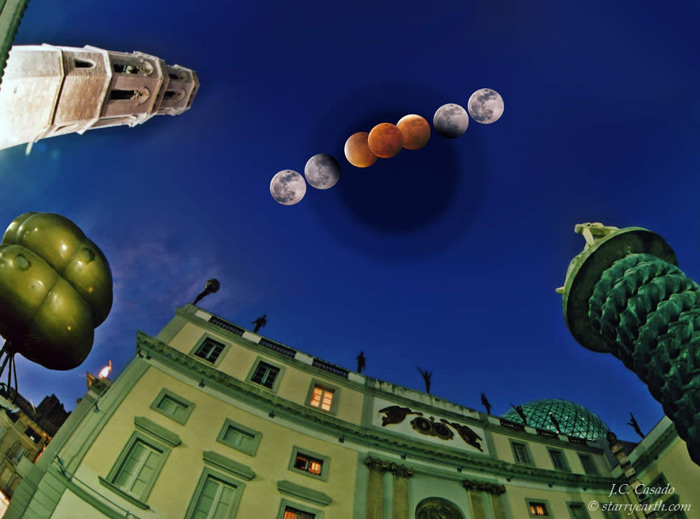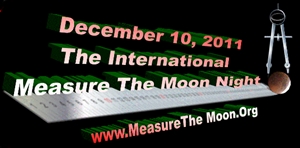
(Image credit: Juan Carlos Casado / Total lunar eclipse over Dalí Theater and Museum in Figueres, Spain.)
The second and last lunar eclipse of 2011 will occur on December 10th, 2011 (the first one happened in June). Total lunar eclipses are much more common than total solar eclipses, and occur on the average of every 6 months. This type of phenomenon is quite remarkable when you realize that (1) the Sun is 400 times larger in diameter than the Moon, and (2) the Sun also just happens to be 400 times more distant than the Moon. This means that the Sun, Earth and Moon are perfectly placed for total eclipses of both the Sun and Moon. When you think of the other planets in the solar system and their moons and distances from the Sun, you realize that we may be the only planet that has such a unique show.
The December 10th eclipse will be visible from all of Asia and Australia, while only the western part of North America will see it (just before dawn). Europe and Africa will encounter the eclipse in progress as the Moon rises at sunset; while the Philippines, Australia, and New Zealand will see it later in the night. Unfortunately, South America and Antarctica will not get to experience it this time.
The partial eclipse begins at 12:45 UT. Totality begins at 14:05 UT; mid-eclipse is 14:32 UT; and the total eclipse ends at 14:57 UT. The partial eclipse ends at 16:18 UT
During totality the Moon is fully within the Earth’s shadow, or umbra; and as the sunlight is refracted around the edge of the Earth, the Moon will glow in a reddish-orange hue as a result of the light passing through Earth’s atmosphere (which absorbs the blue light and lets the red light pass through).
In this eclipse, the Moon will cross to the south of the ecliptic, or path of the Sun. In this situation, the Moon is referred to as being in a “descending node,” and it will be in the lower portion of the Earth’s umbra, or full shadow. As the Moon will make its way through this shadow, totality will last for about 51 minutes.
The way to explain a descending node is that the Moon is not on a perfect ecliptical plane with Earth, since its orbit is tilted about 5.145 degrees. So when the Moon orbits the Earth it has a descending slant on one part of its orbit while the other half is in ascending motion. During this eclipse the Moon will be in the southern portion of the Earth’s umbral shadow.
This eclipse is the 23rd member of the Saros 135 Series. This means that the December 10th eclipse occurs in a cycle of approximately 6,585.3 days or 18 years, 11 days and 8 hours. The term “saros” was first used by the Chaldeans of ancient Mesopotamia, and a “sar” was the unit of measurement they developed to monitor these celestial happenings.
So, when you look for the Moon near the constellation of Taurus on 10 December 2011, you will be continuing a very ancient tradition of eclipse-viewing!
HOW TO GET INVOLVED:
We invite you to join with the “Eclipses without Borders: Total Lunar Eclipse - 10 December 2011” event. Get together with your astronomy group, family, or friends and enjoy the beautiful views of the lunar eclipse. And if the eclipse makes you feel poetic, why not create a poem and send it to AWB's Astropoetry Blog? (Send to [email protected].)
Here’s a fun way you could enjoy writing eclipse poetry as a group activity: One person in the group (usually the host or hostess at a party) begins the poem by writing a 3-line haiku about the eclipse; then he or she passes the paper to the next person, who writes three more lines, continuing the thought in a slightly different way; and so on until each person in the group has added their three lines to the poem. In old Japan, this kind of group-written poem was known as a “renga,” and it was a favorite recreation at dinner-parties. So, how about creating an eclipse renga for our Astropoetry Blog?
We also welcome you to take photos and send them to us with a brief description of your event.
LIVE WEBCAST:
Whenever heavenly bodies transit, eclipse, or occult another object, there are countless interested people who wish they were at the pivotal location for the best viewing. But since these events don’t always work with our desires, you can still experience these events first-hand. You don’t have to feel that the universe isn’t working with you any more! Now you have an option through the Night Skies Network of live broadcast shows. The Night Skies Network site consists of amateur astronomers from all over the world who aim their telescopes at these celestial events. Their telescopes are set up in home observatories, backyards or key imaging locations, all to give you the best view of the night sky.
The Night Skies Network site consists of amateur astronomers from all over the world who aim their telescopes at these celestial events. Their telescopes are set up in home observatories, backyards or key imaging locations, all to give you the best view of the night sky.
In order to view these live-feed sessions, you will need to become a member of the network. Once a member, all you do is check on the homepage and see which people will be streaming an event. If you follow Night Skies Network, you will get a Tweet from the various broadcasters to let you know their viewing status.
These astro-casters use video cameras and other equipment of all sorts to bring the planets and countless other objects to your computer. So if you need a live-feed for the December 10th total Lunar Eclipse, log on and prepare for a fun and enjoyable show.
Other webcasts:
Sky Watchers Association of North Bengal (Live webcast from Himalayan Foothills begins at 12:30 UT)
Astrocamp Observatory, Philippines by Armando Lee, AWB National Coordinator for the Philippines
Astronomy Aotearoa, New Zealand by Paul Moss, AWB active member
SLOOH SpaceCamera
AstronomyLive.com
StarGazersOnline.org by Dean Regas (Cincinnati Observatory) and Marlene Hidalgo, US
Amateur Astronomers Association Delhi, India
AstroNation (Dreieich-Götzenhain, Germany)
List of webcasts from Japan (Japanese working group of worldwide events about astronomy)
INTERNATIONAL MEASURE THE MOON NIGHT:
The eclipse will offer a rare opportunity for students, teachers, and the general public to measure the Moon's distance and size duplicating the same techniques—with a Digital Age twist—used by Greek astronomers thousands of years ago. On the night of December 10th , the magazine The Classroom Astronomer (TCA) will coordinate worldwide measurements of the Moon’s position in the sky and its passage through the Earth's shadow. The measuring methods—key techniques for measuring the Moon’s diameter and distance from Earth, which can be used now and were also used in antiquity—are called the Shadow Method and the Lunar Parallax Method.
On the night of December 10th , the magazine The Classroom Astronomer (TCA) will coordinate worldwide measurements of the Moon’s position in the sky and its passage through the Earth's shadow. The measuring methods—key techniques for measuring the Moon’s diameter and distance from Earth, which can be used now and were also used in antiquity—are called the Shadow Method and the Lunar Parallax Method.
The Shadow Method uses the transit of the Moon through Earth's central shadow, the umbra. The angular size of the cross section made visible by the shadow on the Moon's face is directly related to a unique distance. This kind of measurement was first accomplished by astronomers thousands of years ago.
The Lunar Parallax Method uses a technique familiar to the ancient Greeks, triangulation, but which could not be done successfully then because they could not communicate instantly with observers far from Greece. Two observers today, thousands of miles apart, communicating via the Internet or telephone, can snap photos of the Moon at the same instant. They will see the Moon in front of different star fields, an angular shift directly related to the Moon's distance and the distance between the observers.
For more information on how to participate at International Measure The Moon Night.
RESOURCES:
Information on 2011 Dec 10: Total Lunar Eclipse
Activities from NASA Night Sky Network







